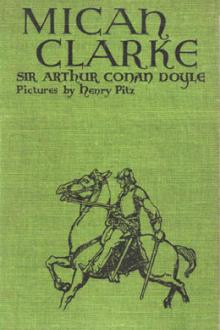Three Thousand Years of Mental Healing, George Barton Cutten [crime books to read TXT] 📗

- Author: George Barton Cutten
- Performer: -
Book online «Three Thousand Years of Mental Healing, George Barton Cutten [crime books to read TXT] 📗». Author George Barton Cutten
"In the year 1853," says Berdoe, "I saw among the more precious drugs in the shop of a pharmaceutical chemist at Leamington a bottle labelled in the ordinary way with the words, Moss from a Dead-Man's Skull. This has long been used, superstitiously, dried, powdered, and taken as snuff, for headache and bleeding at the nose."
Herpes.—Turner151 notices a prevalent charm among old women for the shingles, and which is not uncommonly heard of to-day. It was to smear on the affected part the blood from a black cat's tail. He says that in the only case when he saw it used it caused considerable mischief.
Incubus.—Stones with holes through them were commonly called hag-stones, and were often attached to the key of the stable door to prevent witches riding the horses. One of these suspended at the head of the bed was celebrated for the prevention of nightmare. In the "Leech book"152 we find the following: "If a mare or hag ride a man, take lupins, garlic, and betony, and frankincense, bind them on a fawn skin, let a man have the worts on him, and let him go into his house." Notice the following from Lluellin's poems:
Insomnia.—In the Loseley MSS. we find a receipt "For hym that may not slepe. Take and wryte yese wordes into leves of lether: Ismael! Ismael! adjuro te per Angelum Michaelum ut soporetur homo iste; and lay this under his bed, so yt he wot not yerof and use it allway lytell, and lytell, as he have nede yerto."
Jaundice.—This disease was sometimes cured by transplantation, and Paracelsus gives us a method for carrying this out. Make seven or nine—it must be an odd number—cakes of the newly emitted and warm urine of the patient with the ashes of ash wood, and bury them for some days in a dunghill.
In the journal of Dr. Edward Browne, transmitted to his father, Sir Thomas Browne, we read of a magical cure for jaundice: "Burne wood under a leaden vessel filled with water; take the ashes of that wood, and boyle it with the patient's urine; then lay nine long heaps of the boyled ashes upon a board in a ranke, and upon every heap lay nine spears of crocus: it hath greater effects than is credible to any one that shall barely read this receipt without experiencing."153
Madness.—The early inhabitants of Cornwall used "to place the disordered in mind on the brink of a square pool, filled with water from St. Nun's well. The patient, having no intimation of what was intended, was, by a sudden blow on the breast, tumbled into the pool, where he was tossed up and down by some persons of superior strength till, being quite debilitated, his fury forsook him; he was then carried to church, and certain masses were sung over him. A similar practice of the people of Perthshire is noticed by Sir Walter Scott in Marmion.
Marasmus.—Mr. Boyle relates the case of a physician whose wan face betokened a marasmus, and who was induced to try a method not unlike the sympathetic cures. "He took an egg and boiled it hard in his own warm urine; he then with a bodkin perforated the shell in many places, and buried it in an ant-hill, where it was kept to be devoured by the emmets; and as they wasted the egg, he found his distemper to abate and his strength to increase, insomuch that his disease left him."154
Rickets.—The most common method of dealing with this disease was by drawing the children through a split tree. The tree was afterward bound up and, as it healed and grew together, the children acquired strength; at least, so 'twas said. Sir John Cullum saw the operation performed and says that the ash tree was selected as most preferable for the purpose. "It was split longitudinally about five feet: the fissure was kept open by the gardener, whilst the friend of the child, having first stripped him naked, passed him thrice through it, almost head foremost. This accomplished, the tree was bound up with packthread, and as the bark healed, so it was said the child would recover. One of the cases was of rickets, the other a rupture." Drawing the children through a perforated stone was also a cure for rickets, providing that two brass pins were carefully laid across each other on the top edge of this stone.155
Sciatica.—Sleeping on stones on a particular night was formerly practised in Cornwall to cure all forms of lameness. Boneshave was the term used for sciatica in Exmoor, where the following charm was used for its cure: The patient must lie on his back on the bank of a river or brook, having a straight staff lying by his side between him and the water, and must have the following words repeated over him:
Scrofula.—Scrofula, or "king's-evil," was best cured by the touch of the sovereign, but, if this could not be accomplished, a naked virgin could cure it, especially if she spit three times upon it. Stroking the affected parts nine times with the hand of a dead man, particularly of one who had suffered a violent death as a penalty of his crime, especially if it be murder, was long practised, and was said to be efficacious in curing scrofula.
Sweating Sickness.—Aubrey157 gives a selection of the favorite prescriptions in use against the sweating sickness. Among them was the following: "Another very true medicine.—For to say every day at seven parts of your body, seven paternosters, and seven Ave Marias, with one Credo at the last. Ye shall begyn at the ryght syde, under the right ere, saying the 'paternoster qui es in coelis, sanctificetur nomen tuum,' with a cross made there with your thumb, and so say the paternoster full complete, and one Ave Maria, and then under the left ere, and then under the left armhole, and then under the left hole, and then the last at the heart, with one paternoster, Ave Maria with one Credo; and these thus said daily, with the grace of God is there no manner drede hym."
Thorns.—Three metrical charms have been used for troubles of this kind. Pepys' Diary records "A charme for a thorne":
Another form of the same is this:
Brand gives another thus:
Toothache.—King in his interesting article recites this cure: "Seeth as many little green frogges sitting upon trees as thou canst get, in water: take the fat flowynge from them, and when nede is, anoynt the teth therwyth. The graye worms breathing under wood or stone, having many fete, these perced through with a bodken and then put into the toth, alayeth the payne."159 A nail driven into an oak tree is reported to be a cure for this pain, and bones from a church-yard have from ancient times been used as charms against this disease.
An early idea was that toothache was caused by a worm and that henbane seed roasted would cure it. The following from "The School of Salerne" formulates this superstition:
Even to-day, I suppose, druggists sell henbane seed for this purpose. The seed is used by sprinkling it on hot cinders and holding the open mouth over the rising smoke. The heat causes the seed to sprout, and thus there appears something similar to a maggot, which is ignorantly supposed by the sufferer to have dropped from the tooth.160
Warts.—The cures for warts are many and varied. There have been many charms devised for their removal. Grose gives directions to "Steal a piece of beef from a butcher's shop, and rub your wart with it, then throw it down the necessary house, or bury it, and as the beef rots, your warts will decay."161 Some have great faith in having a vagrant count them, mark the number on the inside of his hat, and then when he leaves the neighborhood he takes the warts with him. Coffin water was also considered good for them.
"For warts," says Sir Thomas Browne, "we rub our hands before the moon, and commit any magulated part to the touch of the dead. Old Women were always famous for curing warts; they were so in Lucian's time."162
Sir Kenelm Digby, in a work already referred to, says: "One would think that it were folly that one should offer to wash his hands in a well-polished silver basin, wherein there is not a drop of water, yet this may be done by the reflection of the moonbeams only, which will afford it a competent humidity to do it; but they who have tried it, have found their hands, after they are wiped, to be much moister than usually; but this is an infallible way to take away warts from the hands, if it be often used."
Black gives us several ways of charming away warts. He says: "Lancashire wise men tell us for warts to rub them with a cinder, and this tied up in paper, and dropped where four roads meet, will transfer the warts to whoever opens the parcel. Another mode of transferring warts is to touch each wart with a pebble, and place the pebbles in a bag, which should be lost on the way to church; whoever finds the bag gets the warts." A common Warwickshire custom was to rub the warts with a black snail, stick the snail on a thorn bush, and then, say the folks, as the snail dies so will the wart disappear.163
Warts, on the other hand, seem in certain cases to be





Comments (0)